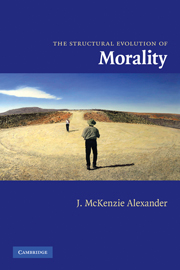2 - Types of evolutionary models
Published online by Cambridge University Press: 27 August 2009
Summary
All evolutionary models contain at least two things: a representation of the state of the population and a specification of the dynamical laws that tell how the state of the population changes over time. Since one cannot specify the dynamical laws without referring to some representation of the population, the choice of representation constrains the set of possible dynamical laws. Even so, given a particular representation, it is usually the case that many different sets of dynamical laws are compatible with that representation.
The main choice that exists regarding the representation of the population is whether to model it using continuous or discrete methods. Continuous, or aggregative, models represent the population using global statistics concerning the distribution of genotypes or phenotypes in the population. The most commonly studied aggregative model is the replicator dynamics, which represents the state of the population by the frequency with which certain genotypes or phenotypes occur. Notice that aggregative models necessarily assume that questions such as which individual in the population has a particular phenotype or genotype are unimportant, since all differences between individuals are lost when one uses frequency data to represent the population state.
- Type
- Chapter
- Information
- The Structural Evolution of Morality , pp. 25 - 52Publisher: Cambridge University PressPrint publication year: 2007



